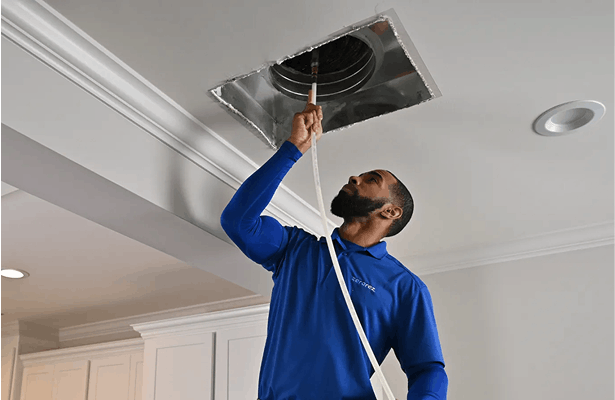Property Management
10 Essential Repairs Every Landlord Should Expect
Last Updated Aug 28, 2025


Table Of Contents
- How We Selected the Top Repairs
- 1. HVAC System Failures
- 2. Plumbing Emergencies
- 3. Electrical System Issues
- 4. Roof Leaks and Water Intrusion
- 5. Appliance Breakdowns
- 6. Door and Lock Problems
- 7. Pest Control Infestations
- 8. Flooring Damage
- 9. Painting and Drywall Wear
- 10. Exterior Upkeep
- How Belong Handles Property Repairs
- Final Takeaway
- FAQ
Owning a rental property often comes with surprises. If you’re someone who inherited a rental, or moved and decided to rent instead of sell, maintenance can quickly become overwhelming. From burst pipes to broken HVAC systems, every home needs attention.
That’s where property managers step in. Their role isn’t just about collecting rent, it’s about keeping your property safe, habitable, and attractive to tenants. Understanding the most common repairs and services they handle helps you set expectations, budget wisely, and avoid liability.
Below are the 10 most common repairs property managers handle, what they cost, and how professional care can save landlords thousands over the long run.
How We Selected the Top Repairs
We identified the ten most common repair categories by combining:
- Frequency of requests: how often tenants submit maintenance tickets.
- Cost impact: average expense to landlords when these repairs aren’t addressed quickly.
- Safety and liability risk: whether delays could expose landlords to lawsuits or code violations.
According to industry research, HVACHVAC and plumbing alone account for nearly 50% of all maintenance tickets, while electrical issues and roof leaks are not far behind . And with national maintenance costs rising 11% year-over-year, knowing what to expect (and who to trust) is critical.
1. HVAC System Failures
Heating and cooling systems are the backbone of tenant comfort, and one of the first things to break under seasonal stress. Air conditioners burn out compressors in the summer, while furnaces struggle in winter. Because HVAC requests account for about a third of all maintenance calls, landlords can count on it being a recurring expense.
Typical costs:
- Emergency HVAC repair: $350 to $1,200
- Full system replacement: $5,000 to $12,000
Savings when handled early: Preventive servicing twice a year can extend a system’s life by up to 15 years, sparing landlords $7,000 to $10,000 in premature replacements.
2. Plumbing Emergencies
Few things cause more stress for tenants (or damage to your property) than plumbing problems. Burst pipes, clogged drains, and failing water heaters can happen suddenly and spread damage quickly if not handled by professionals. Since plumbing represents nearly a quarter of all maintenance requests, landlords should expect it to be at the top of their list.
Typical costs:
- Clogged drain: $150 to $300
- Burst pipe repair: $500 to $2,500 (excluding water damage restoration)
- Water heater replacement: $1,200 to $3,000
Savings when handled early: A $200 fix today can prevent $10,000+ in mold remediation and flooring replacement later.
3. Electrical System Issues
Electrical issues often start small, like a tripping breaker or flickering light, but they carry significant safety risks. Left unchecked, outdated panels or exposed wiring can lead to code violations or worse, fires. With electrical repairs making up nearly 20% of maintenance requests, this is one category you can’t afford to ignore.
Typical costs:
- Outlet or light fixture repair: $100 to $250
- Circuit breaker replacement: $500 to $2,000
- Panel upgrade: $3,000 to $6,000
Savings when handled early: Proactive upgrades prevent hazards that could lead to six-figure lawsuits or catastrophic property damage.
4. Roof Leaks and Water Intrusion
A small water stain on a ceiling is often the first sign of a roof problem, but by then the damage may already be spreading. Missing shingles, cracked flashing, or clogged gutters all contribute to leaks. Water intrusion doesn’t just stain drywall, it weakens the structure over time.
Typical costs:
- Leak repair: $300 to $1,200
- Roof replacement: $7,000 to $12,000
Savings when handled early: Semi-annual inspections can add 5 to 10 years to a roof’s life, preventing $15,000+ in interior water and mold damage.
5. Appliance Breakdowns
Appliances may not be structural, but they play a huge role in tenant satisfaction. Refrigerators stop cooling, dishwashers leak, and washers or dryers burn out motors. Because appliances see heavy daily use, breakdowns are a near certainty in long-term rentals.
Typical costs:
- Small repair: $150 to $400
- Appliance replacement: $600 to $2,500
Savings when handled early: Simple preventive steps, like cleaning refrigerator coils or replacing washer hoses, can avoid $5,000+ in water damage or emergency replacements.
6. Door and Lock Problems
Nothing makes tenants more uneasy than a broken lock or door that won’t shut properly. Beyond the security risk, landlords may face liability if a tenant experiences a break-in due to faulty locks. For this reason, rekeying or replacing locks is one of the most common property management tasks, especially between tenancies.
Typical costs:
- Rekeying: $100 to $250
- Lock replacement: $150 to $400
- Smart lock installation: $250 to $600
Savings when handled early: Quick action avoids tenant turnover and prevents losses from break-ins, which can run $2,000 to $5,000 in damages and downtime.
7. Pest Control Infestations
Tenants don’t tolerate pests for long, and neither should landlords. Ants, cockroaches, rodents, and termites are the most common offenders in rentals, and they spread quickly without intervention. A single infestation can jeopardize tenant retention and lead to extensive property damage.
Typical costs:
- Single pest treatment: $150 to $350
- Quarterly pest service plan: $500 to $1,200 annually
- Termite damage repair: $3,000 to $8,000+
Savings when handled early: Quarterly service can cut infestations by up to 85%, avoiding structural repairs that easily climb into the five-figure range.
8. Flooring Damage
Floors take the brunt of daily life, spilled water, dropped furniture, high foot traffic. Whether carpet, hardwood, or tile, damage is inevitable over time. Addressing issues promptly can mean the difference between a simple repair and a full replacement.
Typical costs:
- Carpet cleaning: $200 to $500
- Tile repair: $200 to $500
- Hardwood refinishing: $3 to $5 per sq ft
- Full replacement: $5,000 to $15,000+
Savings when handled early: Spot repairs and routine cleaning can delay replacement by years, saving thousands during tenant turnover.
9. Painting and Drywall Wear
Walls inevitably suffer wear and tear, from nail holes to scuffs to tenant move-out damage. Repainting and patching are some of the most frequent turnover tasks, and they play a big role in how quickly a property rents again.
Typical costs:
- Patch and paint small area: $150 to $400
- Full interior repaint: $1,200 to $3,500
Savings when handled early: Touch-ups extend the lifespan of a full paint job and reduce vacancy periods by presenting a fresh, well-maintained property.
10. Exterior Upkeep
The outside of your rental is just as important as the inside. Siding, gutters, and landscaping are constantly exposed to weather and neglect here can cause water intrusion, pest problems, or city code violations.
Typical costs:
- Gutter cleaning: $150 to $300
- Siding repair: $400 to $1,500
- Landscaping maintenance: $100 to $400 monthly
Savings when handled early: Routine upkeep prevents foundation damage from poor drainage, which can cost $10,000 to $25,000 to fix.
How Belong Handles Property Repairs
Belong makes maintenance painless by managing everything on your behalf. Here’s how it works:
- Triage
Meet Phin, Belong’s AI property care assistant. When residents submit an in-app repair request, Phin collects details, photos, videos, and descriptions, and guides them through step-by-step troubleshooting. Many common issues, like tripped breakers or clogged drains, can be resolved immediately without waiting for a technician. This saves time, cuts unnecessary costs, and makes life easier for everyone. - Concierge Team Dispatch
If the issue can’t be solved on the spot, Phin automatically triages it, classifying urgency and type, then passes all the details to Belong’s concierge team. Our experts are available 24/7 to dispatch vetted, insured professionals who can fix the problem quickly and correctly the first time. - Responsibility Allocation
Not every maintenance request falls on the homeowner. Belong helps streamline this by clearly distinguishing responsibilities so there’s no confusion.
- Tenant Responsibilities: Residents are expected to handle minor issues that fall under normal upkeep or daily use. Examples include replacing light bulbs, unclogging a drain they’ve blocked, resetting a tripped breaker, or changing HVAC filters. These are part of routine household care and are typically quick fixes that don’t require professional intervention.
- Homeowner Responsibilities: Larger repairs and anything related to the property’s structure, systems, or appliances provided with the home are the homeowner’s responsibility. This includes things like fixing a leaking roof, repairing or replacing major appliances, addressing plumbing or electrical issues, or servicing the HVAC unit.
- Landlord Visibility and Control
Landlords get real-time estimates, approvals, and final invoices in their dashboard. That means no surprises, full transparency, and complete control over repair decisions. - Proactive Preventive Care
Belong also schedules preventive maintenance based on property data, things like seasonal HVAC servicing, roof checks, and water heater flushes, so emergencies are less likely to happen in the first place.
This tech-driven approach means landlords never have to scramble for contractors or second-guess repair quality. Instead, they enjoy:
- Predictable, transparent costs
- Faster resolutions thanks to AI triage + human concierge
- Guaranteed quality service from trusted professionals
- Peace of mind that both their home and their residents are cared for
Final Takeaway
Repairs aren’t just about fixing what’s broken, they’re about protecting your investment, avoiding liability, and keeping your property competitive. By understanding the 10 most common repair categories, you can budget wisely and act quickly.
With Belong, you don’t just get repairs handled, you get a full-service partner that keeps your property profitable and stress-free.
FAQ
1. What common repairs do property managers handle?
Plumbing, HVAC, electrical, roofing, appliances, locks, pest control, flooring, painting, and exterior upkeep.
2. What services do home-maintenance companies typically provide?
Emergency response, preventive maintenance, vendor scheduling, warranty coordination, and 24/7 tenant support.
3. Should I handle repairs myself or hire a professional?
DIY is fine for small fixes (light bulbs, filters), but plumbing, HVAC, electrical, and structural work should always be left to licensed pros.
4. What are my landlord's repair obligations?
You must provide a safe, habitable home with functioning plumbing, heating, and electrical systems, plus protection against infestations. Ignoring these can lead to withheld rent or legal penalties.
About The Author
Eric Vandekerkhove
Marketing Manager
Join me as I share insights drawn from years of hands-on experience. Whether it’s navigating the latest trends in real estate, sharing practical tips for property management, or discussing the nuances of building lasting relationships with clients, my goal is to offer guidance that’s as practical as it is inspiring.




